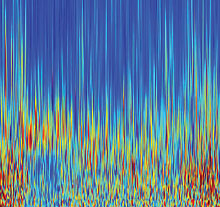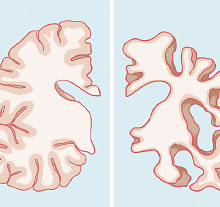Journal Digest: TMS & Negative Emotions; Casual Smokers & Tobacco Use Disorder; Biosensor & Serotonin Changes; Tau Variant & Alzheimer’s Progression; Impact of Childhood Behavioral Intervention; Machine Learning Program Predictions
Riluzole Augmentation May Reduce Hyperarousal Symptoms

A study in the Journal of Neuroscience reports that transcranial magnetic stimulation (TMS) of the prefrontal cortex may help to improve emotional regulation. Combining targeted TMS with behavioral therapies may benefit people with autism, posttraumatic stress disorder, or other psychiatric disorders.
Researchers at Shenzhen University in China and colleagues enrolled 90 healthy volunteers for the study. The participants received either three sessions of active TMS (to dorsolateral prefrontal cortex or ventrolateral prefrontal cortex) or sham TMS. After each session, the participants viewed pictures depicting social exclusion (for example, showing a person being left out of a group) while receiving EEG scans.
During the first viewing of the images, the study participants received no instructions. For the second and third sessions, they were instructed to think about something unrelated to images (distraction) or think about the images in a positive way (reappraisal). After the sessions, the participants were asked to rate their feelings about the images.
Both the participant responses and EEG readings showed that those who received active TMS were better able than the sham group to temper their emotional reaction to the images using distraction or reappraisal. The investigators further identified regional specificities: Those who received TMS to the dorsolateral prefrontal cortex were better able to use distraction techniques, while those who received TMS to the ventrolateral prefrontal cortex were better able to use reappraisal techniques.
Jun Zhao J, Mo L, Bi R, et al. The VLPFC vs. the DLPFC in Down-Regulating Social Pain Using Reappraisal and Distraction Strategies. J Neurosci. December 21, 2020. [Online ahead of print]
Some Casual Smokers May Meet Criteria For Tobacco Use Disorder

Nearly half of people who do not smoke daily meet the DSM-5 criteria for tobacco use disorder, according to a report in the American Journal of Preventative Medicine.
“Clinicians should ask about all smoking behavior, including nondaily smoking, because such smokers may still require treatment to successfully quit smoking,” wrote the authors from Duke University and Penn State University.
The researchers analyzed data collected from 36,309 participants of the National Epidemiological Study of Alcohol and Related Conditions−III, conducted from 2012 to 2013. This group included 6,793 adults who reported past-year cigarette use. The smokers were evaluated for tobacco use disorder according to criteria outlined in DSM-5.
As expected, the proportion of smokers with tobacco use disorder increased with cigarette consumption, from 65% among people who reported smoking one to four cigarettes a day to 83% among those smoking 10 cigarettes a day and 91% of those smoking 20 or more cigarettes a day. Among nondaily smokers, the prevalence of tobacco use disorder was 26% in people smoking less than once a week, 47% in those smoking one to two days a week, and 64% in those smoking three to six days a week.
The investigators suggested the high prevalence of tobacco use disorder may be the result of changes in diagnostic criteria to include mild tobacco use disorder in DSM-5.
“Lighter smoking is frequently perceived as less harmful. Consequently, such smokers may be less likely to be identified by medical providers and less likely to receive appropriate treatment,” they wrote. “Continued efforts to identify optimal cessation approaches for this population remain an important direction for future research.”
Oliver JA, Foulds J. Association Between Cigarette Smoking Frequency and Tobacco Use Disorder in U.S. Adults. Am J Prev Med. December 22, 2020. [Online ahead of print]
Biosensor Tracks Serotonin Changes in Real Time

A team led by researchers from the University of California, Davis, has developed a biological sensor that lights up in the presence of serotonin, enabling researchers to visualize changes in serotonin levels in neurons in real time. The findings were published in Cell.
The investigators used computational modeling to modify a bacterial protein that binds the chemical acetylcholine so that it instead binds serotonin. This modified protein, called iSeroSnFR, was then linked to a fluorescent molecule that lights up when serotonin is bound.
In studies of mice injected with the sensor iSeroSnFR, the researchers observed a natural flow in brain fluorescence; signals rose sharply when the mice awoke, continued to increase during the day, decreased after sleep onset, and then dropped further once the mice reached REM sleep.
In follow-up studies, the researchers observed rising fluorescence in the prefrontal cortex and amygdala in mice learning to associate audio cues with forthcoming foot shocks.
The investigators also tested the sensor on neurons in lab dishes and observed changes in fluorescence intensity when the neurons where exposed to serotonin-releasing or -blocking drugs such as 3,4-methyl enedioxy methamphetamine (MDMA) or the antidepressants escitalopram and vilazodone.
Given how dysfunctional serotonin transport contributes to psychiatric illness, this sensor could be useful in screening novel drug candidates or testing existing drugs on patient stem cells to identify optimal doses, the researchers wrote.
Unger EK, Keller JP, Altermatt M, et al. Directed Evolution of a Selective and Sensitive Serotonin Sensor via Machine Learning. Cell. 2020; 183(7): 1986-2002.e26.
Tau Variant in Spinal Fluid May Indicate Alzheimer’s Progression

esearchers at the Washington University School of Medicine have identified a form of tau protein in spinal fluid that may indicate the progression of Alzheimer’s disease. The findings were published in Brain.
Most of the toxic clumps of tau found in the brains of people with Alzheimer’s contain a part of the protein known as the microtubule binding region; this region is absent in soluble tau fragments in the blood or spinal fluid that are commonly used as biomarkers.
The researchers developed a highly sensitive method to isolate and analyze tau fragments from the spinal fluid of 58 individuals at various stages of Alzheimer’s (from preclinical to moderate), along with 12 people with non-Alzheimer’s cognitive impairment and 30 cognitively healthy controls. They identified three versions of tau in the Alzheimer’s samples that contained microtubule binding regions known to be present in Alzheimer’s brain tissue: MTBR-tau-243, MTBR-tau-299, and MTBR-tau-354.
Of these three, MTBR-tau-243 was the only variant whose concentration increased incrementally as Alzheimer’s progressed. The levels of MTBR-tau-243 in spinal fluid strongly correlated with the amount of tau accumulation in the brains of the individuals, as assessed by PET scans.
“Our findings that MTBR-tau highly correlates with Alzheimer’s disease pathology and clinical progression stages provide important insights into promising targets for therapeutic anti-tau drugs to treat tauopathies,” the researchers wrote.
Horie K, Barthélemy NR, Sato C, Bateman RJ. CSF Tau Microtubule Binding Region Identifies Tau Tangle and Clinical Stages of Alzheimer’s Disease. Brain. December 7, 2020. [Online ahead of print]
Long-Lasting Impact Of Childhood Behavioral Intervention Revealed

Fast Track—a comprehensive intervention designed to improve emotional awareness and regulation in children with aggression problems—may help to reduce later risk of premature death as adolescents and young adults. As reported in PNAS, young adults who received Fast Track as children were less likely than those who did not to engage in so-called “behaviors of despair,” such as hazardous drinking, opioid use, suicidal ideation, or self-harm.
Fast Track began in 1991 and enrolled nearly 900 kindergarteners who were identified by teachers and parents as having behavioral problems. Half of the students received Fast Track, a 10-year intervention focused on improving emotional regulation and interpersonal skills, while the remainder received usual school services. After the intervention ended at age 15, the children continued to be assessed yearly until 20 and then once again at 25. During these assessments, youth were asked about four behaviors of despair: suicidal ideation and attempts, opioid use, and hazardous drinking (defined as 21 or more drinks a week for men, 14 or more drinks a week for women, or four binge drinking sessions of five or more drinks a week regardless of sex).
For this study, investigators at Duke University and colleagues assessed data from 335 Fast Track recipients and 358 controls. They found that only 24.6% of Fast Track children reported any of the behaviors of despair compared with 34.3% of control children.
Compared with those who did not receive the intervention, youth who received Fast Track were 31% less likely to report self-harm, 45% less likely to report hazardous drinking, 45% less likely to report suicidal ideation, and 61% less likely to report opioid use.
“The breadth and magnitude of the positive impacts make a clear case for the value of early holistic, developmentally informed psychological interventions that involve the child, family, and school in mitigating preventable self-inflicted mortality,” the investigators concluded.
Godwin JW, Bierman KL, Coie JD, et al. The Fast Track Intervention’s Impact on Behaviors of Despair in Adolescence and Young Adulthood. Proc Natl Acad Sci USA. 2020; 15; 117(50): 31748-31753.
Machine Learning Program Predicts Mood Problems After Stroke

Mood disorders, such as depression and anxiety, commonly occur in stroke patients and can have a negative impact on patients’ physical and cognitive recovery. Researchers at Hiroshima University in Japan and colleagues report that they have created a machine-learning program that can predict which patients are most likely to develop mood disorders after a stroke.
The researchers obtained clinical data from 274 stroke patients who underwent up to 180 days of rehabilitation at Hiroshima’s Hibino Hospital. The patients were divided into four groups based on their mood symptoms: depression, apathy, anxiety, or none (control). They then used machine-learning software to look for patterns in the clinical evaluations (which included cognitive tests, measurements of stroke severity, and psychological assessments) of patients in each of the four groups. Based on that data, the researchers developed a model that could predict the onset of depression or anxiety with about 90% accuracy and apathy with 85% accuracy.
For all three mood problems, the patients’ scores on the Japanese version of the Perceived Stress Scale contributed the most strongly to the risk of future symptoms.
The researchers noted that this finding points to the importance of perceived stress in post-stroke mood disorders. The findings were published in Scientific Reports. ■
Hama S, Yoshimura K, Yanagawa A, et al. Relationships Between Motor and Cognitive Functions and Subsequent Post-Stroke Mood Disorders Revealed by Machine Learning Analysis. Sci Rep. 2020; 10(1): 19571.



